Engagement ring setting options
How to find the right setting for your diamond ring
Ringspo is reader supported
Ringspo is reader-supported, which means we may receive a commission if you click a link to a retailer & subsequently make a purchase.
We feature links to several retailers to help readers find the one that is the best fit for them. Find out more about how Ringspo works here.
In a recent survey by theknot.com, a over-whelming majority of women chose the engagement ring setting as the most important characteristic of their ring.
So what are engagement ring settings? Well they’re not something that you can dial in with nobs and levers on some sort of control panel. The ring setting is the way that the stones are placed on the band. It’s the ring’s format and style and the defining characteristic of what a ring looks like.
In this post I’ll talk you through the most common and classic settings, as well as the one thing you can do to ensure that your surprise proposal goes off without a hitch, even if you don’t know what setting to go for.
Solitaire diamond ring settings
A solitaire setting has a single main stone in the centre of the ring – usually a round or a princess cut.
They’re a simple setting which can keep the cost of the band and setting down, but because there are no side stones to support the main one, the centre stone is out there flapping in the wind and has to do the impressing on its own.
Solitaires are held in place with either four or six prongs. Having four allows the most light to enter the stone, which lets it to sparkle to the best of its ability. Six prongs, sometimes called the Tiffany setting because it was first produced by Tiffany & Co., holds the stone more securely but doesn’t allow quite as much light in.
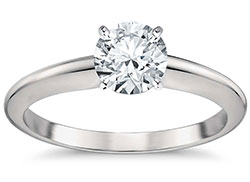
Bezel settings
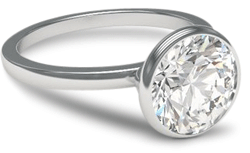
A bezel setting has a metal rim that surrounds the sides of the stone and extends just above it.
This is a secure setting and its low profile means it’s suitable for women with active lifestyles – it won’t get snagged on anything and the bezel will protect the stone.
It’s also suitable for softer stones, as the bezel around the rim of the stone adds a layer of protection and can help prevent the centre stone from becoming chipped.
With more metal than a solitaire, it can be slightly more expensive.
Pavé (pronounced pa-vay)
Pavé is a ring ‘paved’ with diamonds – lots of small diamonds covering the whole ring, sometimes even the underside of the band.
The advantage here is the bling you can get for not too much money. The small diamonds are relatively inexpensive but the effect is impressive.
It’s a good option to support a smaller centre stone, although the cost of the increase in complexity and the number of supporting stones usually matches the reduction from the smaller centre stone.
One way to reduce the budget is to go for a ‘half pavé’, where only the top of the band has stones.
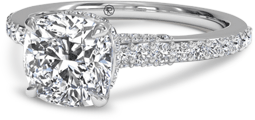
Halo engagement ring settings
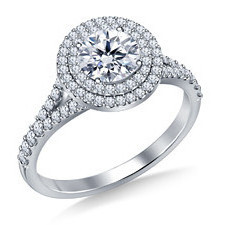
A halo setting has a ring of smaller stones (the halo..) surrounding one large central stone. The halo stones can either be the same as the central stone, or you can mix it up with another colour. Halo settings will make a centre stone look bigger, which is great if you are going to go with a smaller centre stone.
There are many combinations of style and stone for the halo setting, with single, double or even triple halos of stones available and different combinations of diamonds and other precious stones.
Three stone ring settings
Three stone rings are sometimes called ‘past, present and future’ rings, with the the stones said to represent the past, present and future of your relationship.
The advantage of a three stone setting for you is that you can Channel Set rings a higher carat weight of diamond for a greatly reduced price. For example, three 1/3 of a carat stones on a ring is much cheaper than a one carat solitaire.
The side stones don’t need to be the same shape or even the same stone as the centre. Again, a great solution if you don’t want to go with a whopping rock in centre.
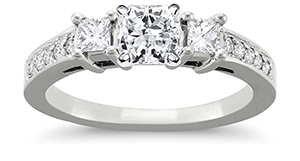
Channel Set rings
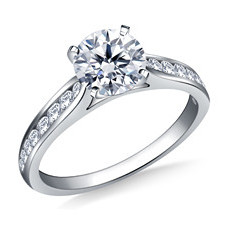
Channelling can be added to any ring to give it a bit of extra pizazz.
It’s often added to solitaires to give extra sparkle and works wonders if you can’t stretch to a large centre stone.
One thing to watch for is dealers trying to pull the wool over your eyes by quoting the ‘Total Diamond Weight’. A ring with a TDW of 1.5 carats may only have a centre stone of 0.7 carats, and should be significantly less expensive than a ring with a centre stone of 1.5 carats.
Vintage diamond rings
You may want to go vintage to avoid worries about blood diamonds, or because you think it will match your girlfriend’s style. Vintage is a broad subset, but consists mainly of the following:
- Victorian
- Edwardian
- Art deco
I’ve got a whole post dedicated to vintage rings – check it out here.
Finding a setting that works
One thing to consider when choosing a setting is what will look best on your ladyfriend’s fingers. Some things to think about are:
- Women with long, slim fingers can get away with most of the styles listed
- Delicate settings can get lost on large hands, making the hands look bigger and the ring smaller (not good)
- Wide bands make fingers look shorter
- Big chunky settings such as the pavé can look oversized on a small hand
- An elongated centre stone, such as a marquise or oval can make short fingers look longer. For more on stone shapes, check this post.
- If your girl has an active lifestyle, a ring that sits up above the band, like a pronged solitaire, can get snagged on clothes or equipment
Setting really is one thing that you need to get right, so if you were previously planning to go it alone but are now not sure, there’s no shame playing it safe and consulting your girlfriend.
The Get Out Clause
If you’re not sure about what setting to go for, but don’t want to ask your other half what she wants because you want to keep it a secret, then you do have one option that not many guys know about.
There is a way that you can get your girlfriend involved in the choice of the setting, but still knock her socks off with a surprise proposal.
How?
Well, most jewelers will sell you just a stone on it’s own, and supply it with a box too.
Choosing this route will mean that you can still drop to one knee with a box and something shiny, but still get your lady-friend involved in the part of the ring choice process that is most important to her: selecting the setting.
And, to make that none of the magic is lost in the proposal, some jewellers will mount the stone in a temporary mock-setting, so you can still slip it onto her finger when she says yes.
For me, this is the best of both worlds: you can research and buy the stone that fits within your budget and plan a surprise proposal, while she will be able to choose the ring that she has always imagined receiving.
